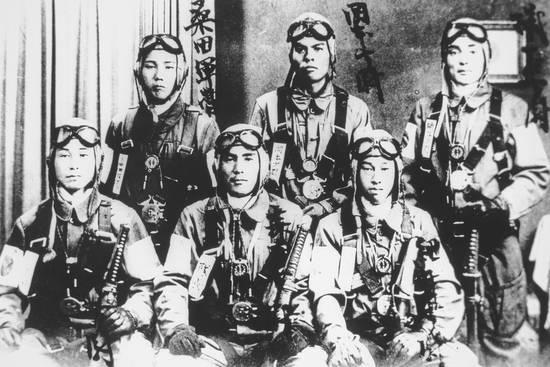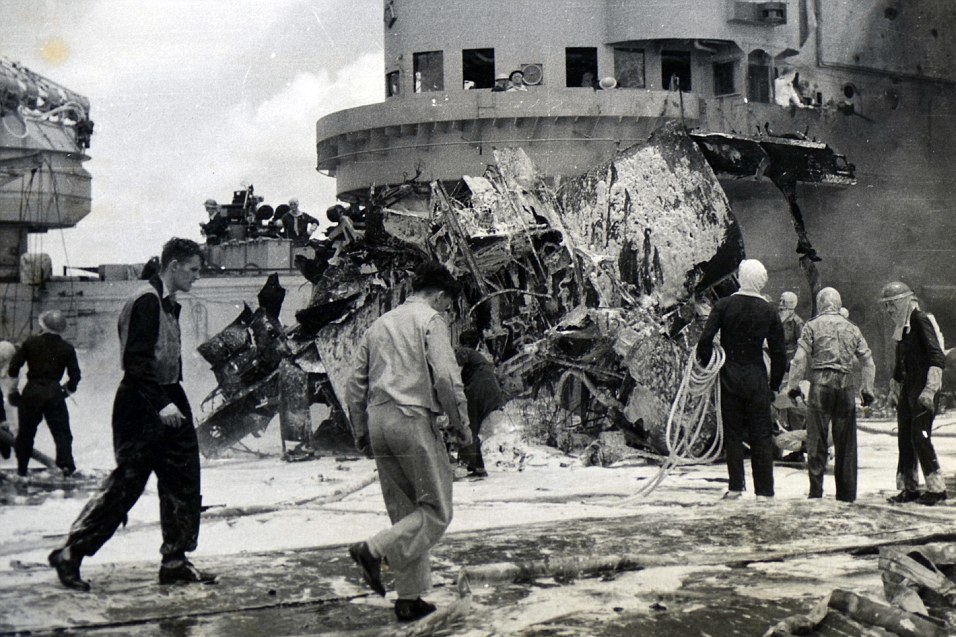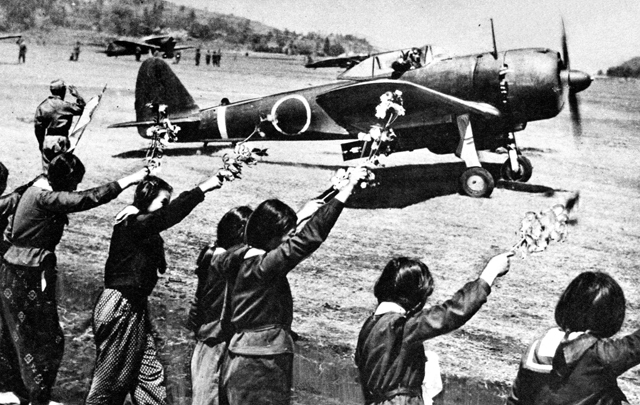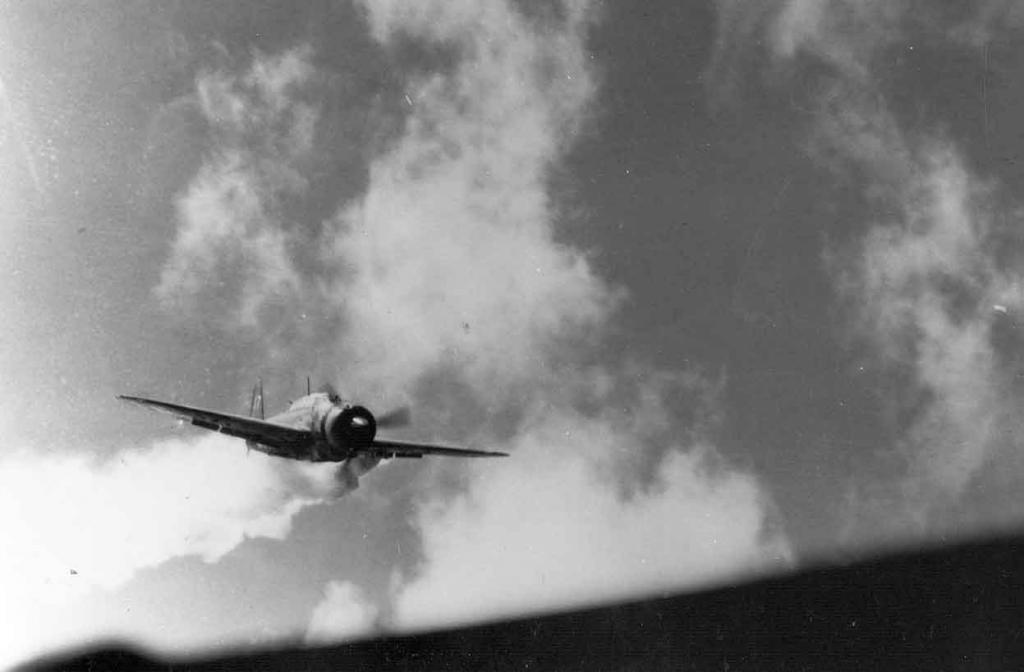Sakura is fading fast. Her fleeting beauty is symbolic for the Japanese. Sakura blossoms are like the bright and brief life of a samurai. Just like flower petals, flying around before they fade, in the prime of life, Japanese kamikaze passed away.
The last weapon of the emperor
In the last ten months of World War II, the Land of the Rising Sun has faded. As their last weapon, Japanese generals and admirals selected about 25 people to carry out tasks involving organized suicide. The world remembers these people today under the name "kamikaze." The damage done by the kamikaze was terrible. The sunken or damaged ships of the Allies only had time to count. Many ships were so badly damaged that they had to be withdrawn from the theater of operations. More than seven thousand American servicemen, men and women, died as a result of organized attacks by the corps of kamikaze pilots. Tens of thousands were injured. The reason for their incredible suffering was two thousand Japanese kamikaze pilots who did not stop at anything and were ready to die for the idea. It is impossible to overestimate these losses for the families of both warring parties. Girls and boys lost their fathers, mothers - sons who will never come home again. Kamikaze lived outside the concepts of grief and anguish. They sacrificed themselves in the name of ideals. But in vain. Kamikaze (translated from Japanese into Russian - "divine wind") should have been the answer to the invaders. The wind was strong, but it did not prevail. At this stage, the empire was already doomed. But the prologue to the breakup was four years before the advent of the kamikaze.

Death awaits
After the Japanese attack on Pearl Harbor, which shocked the whole world, the American armed forces did everything to retaliate against the aggressor. Japanese pilots managed to sink the core of the American fleet, but they missed the American aircraft carriers that were on the march at sea during the attack. These flat-deck ships were to form the core for a counterattack to level the situation in the sky over the Pacific Ocean.
Fight for Midway Island
On April 18, 1942, five months after Pearl Harbor, Colonel Jimmy Doolittle and his guys took off from the deck of an American aircraft carrier, choosing Tokyo as their target. So 16 aircraft brought the war to the Japanese people. It was clear to both sides that planes and take-off decks would be key forces in this ongoing war. Three months later, in June, the Japanese attacked Midway Island. But the Americans cracked the Japanese codes and were now ready and waiting. The Japanese lost 322 aircraft, four aircraft carriers and 3,500 citizens, including their best pilots flying over Midway. Admiral Isoroku Yamamoto was at the helm of an air attack on Midway. Vice Admiral Chuichi Nagumo commanded the formation of aircraft carriers. There is evidence that even then eight staff officers suggested using ramming attacks, in which the pilot had to be sacrificed. So for the first time they started talking about kamikaze (translation from Japanese into Russian - "divine wind"). Yamamoto did not want to hear about it. The humiliation from defeat in naval combat was not familiar to the Japanese since the 15th century. And now it has become a difficult reality for Japanese citizens.

In addition to the aircraft carriers that did not suffer at Pearl Harbor, the Americans also developed faster and more maneuverable aircraft carriers that were deployed for combat missions. During the 1942-1943s. American forces were getting closer to Tokyo. One of the problems of the Japanese was the lack of aircraft. In addition, good pilots were needed. On June 19, 1944, in the battle known as the Great Mariana Collision of Ships, the Land of the Rising Sun lost ten times more aircraft than its allies.
Kamikaze attack
As the Allied forces advanced from one island to another, the military formations of the empire felt more and more in extreme distress. Very soon, American troops will be so close that they can threaten the native islands of Japan. The Allies continued to master their successful strategy of "jumping" from island to island. But the closer they came to Japan, the more obvious it became to them the fearlessness with which the Japanese were going to defend their native islands. In Saipan, a huge number of civilian and paramilitary people chose to commit suicide instead of surrendering to the enemy. Believing that many of them would be enslaved and killed by the invaders, many of their Japanese chose to take the poison and throw a grenade under their feet instead of surrendering. One soldier wrote in his diary: "I finally came to the place where I will die. I am pleased to note that I will die calmly, in the true spirit of sunrise." Photos of Japanese kamikaze survived to this day. Shocked American soldiers began to realize that the eastern attitude to suicide was radically different from their understanding. Now they saw the unimaginable.

Japan versus the world
Meanwhile, in Europe, the Allies had already survived the day of the landing in Normandy and were advancing further to liberate Paris. After that there will be Berlin. And Japan was expecting the first defeat in history. It was that bitter pill that the highest ranks of the empire were not ready to swallow. Events developed so that soon Japan was to fight against the whole world. Such was the situation when American tactical forces in a group approached Leyte Gulf in October 1944. If the allies return to the Philippines, it will only be a matter of time before they take the Japanese islands. The Japanese developed a counter-plan to counter the onslaught of the Americans. Immediately several military leaders argued about the need to use Japanese kamikaze pilots. The main supporter of these methods was the Commander-in-Chief of the Aviation Tokijiro Onishi. It was at this time that Japanese kamikaze appeared on the scene of hostilities.
Protecting Leyte Gulf
The first squadron of "divine wind" was formed in October 1944. Officially, they were understudies for specialized shock groups. The decision to form this group came from Commander-in-Chief Tokijiro Onishi. Japanese kamikaze in World War II became a serious stumbling block for the Allies in the campaign to return the Philippines. When the battle for Leyte began in October, a panic seized the Americans, because there was no effective defense against the Kamikaze squadron. In Japan itself, this method was exalted as a new secret weapon, a new glorious invention in the art of war. Knights of the "divine wind" were revered as saviors.
From the very beginning of the war, Japanese kamikaze demonstrated two main types of attacks:
- The plane flew to the target at an extremely low altitude directly above the waves in order to avoid fixation by radars. As soon as the pilot saw the target, he climbed to achieve acceleration before the last dive.
- For the second method, it was necessary to accumulate clouds as a cover. The pilot was required to gain maximum height, and then fall at an angle to the target as soon as it appeared in his field of vision.
Pilots were instructed to aim on the lifting deck mechanisms. An explosion in this sector not only damaged a large number of aircraft in the hangar, but also made flight operations impossible. For the Japanese kamikaze themselves in World War II, the worse prospect of dying was only the prospect of not dying. Failure to find an enemy ship meant that it was necessary to return to base and prepare for the inevitable death the next day.
Group departures
After the tactical group was formed, Japanese kamikazes began to fly in groups of 5-10 aircraft, and only some of them planned a deadly mission. The rest had to provide cover. In addition, they had to witness this event and report it to the emperor. To confuse the enemy, kamikaze made it a rule to fly without striking at those ships that were returning from the battle zone. American radars were already sophisticated enough, but not enough to determine who was who. And although at dusk the Japanese kamikaze pilots appeared more often than usual, they could fly at any other time of the day or night. In the early days of the Battle of Leyte, almost every U.S. aircraft carrier from a tactical group off the coast of the Philippines was attacked by a suicide plane. The dream of those who invented kamikaze tactics ("one plane - one ship") became a reality.
"Divine wind"
How did it happen that people abandoned everything for the sake of a crumbling empire? These pilots were the newest incarnation of the "divine wind" that defended the Japanese islands for centuries. Year 1241 - Khan Khubilai decided that the Mongol Empire should expand and include the Japanese islands. The commander in chief of the Japanese islands had very different thoughts on this subject. The Mongols gathered a huge army on the Chinese and Korean shores and were on full alert. Strongly inferior in numbers, the Japanese warriors only thought about how long they would last. Then the typhoon rose and destroyed the invading armada, which saved Japan itself. The storm was correlated with the deity of the Sun. This legend has since been told in Japanese schools to all boys and girls. This event occurred during the development of the feudal system. Among the most powerful castes of those times were samurai. It was a caste of warriors who actually ruled the country until the 19th century. At that time, loyalty to the emperor, who was considered a god on earth, was valued above all. The creators of the Kamikaze squadron turned, in fact, to a centuries-old historical tradition.
US Navy Losses
For the Americans, 1944 ended with a terrible sign when the typhoon raged on December 17, as if he wanted to repeat the actions of those kamikazes who took his name. The hurricane overtook the fleet. And when the ships tried to get out of the storm zone, the wind seemed to be trying to overtake them. The fleet "floundered" on the waves, losing more than 800 people. For some time, the kamikaze flights stopped. This made it possible for the Americans to lick their wounds. But not for long. Thirsting to find their target and not wanting to return to the base without hitting it, the Japanese kamikaze in the second attempt began to threaten small ships. Gradually, American patrols became better and better to succeed in intercepting kamikazes.
New Kamikaze division
Successfully completed tasks, the exhausted ranks of kamikazes needed to be replenished. Therefore, on January 18, a fresh division of suicide pilots was formed. The Americans decided to temporarily withdraw their aircraft carriers from the battle zone. The biggest bet for the allies in this struggle was to eliminate the Japanese aircraft industry so that the kamikaze would no longer receive the components necessary for their struggle. For this purpose, the B-29s were first commissioned. This bomber was so big that it received the nickname "super-strength".
New suicide
It was time to directly recognize the new reality. And it was such that the Japanese people would soon have to defend their land from the invasion of American bombers. The B-29 flew at an altitude of 30,000 feet, but in order to drop projectiles in Tokyo, it was necessary to drop to an altitude of 25,000 feet. What was really bad for the Japanese was that their fighters could not reach this mark. As a result, the allies completely excelled in the air, which completely demoralized the Japanese military. The raids on the Japanese islands were carried out continuously. And since most Japanese houses were built of wood, the bombing took place with very high efficiency. By March 10, about a million Japanese were homeless as a result of American raids on Tokyo. A new kamikaze unit was urgently created. Their armor was completely removed, which made them especially light and made it possible to rise to the required height. The new unit was named "Shen Taek," or "Earth Shaking." But the number of American bombers was too large. The Japanese people began increasingly to think about the inevitable defeat.

Kaiten
As the war became increasingly hopeless, the concept of using kamikaze expanded. Suicide boats with bombs embedded in them were created. All of them were developed as a means of countering the invasion of their native land. A suicide attack could be carried out in a variety of ways. The so-called Japanese submarine kamikaze also appeared - small boats with two submariners-suicides. They were called kaiten. The Japanese were going to do their utmost to develop the production of such suicide boats in order to repel the inevitable invasion of Japan. The servants of the emperor continued to fight fiercely. Some historians believe that the successful use of ramming suicide attacks forced President Truman to decide on the use of nuclear weapons. The explosion of a nuclear bomb may have stopped the war, but it became a prologue to new horror. So ended this long bloody war. Japanese kamikaze forever entered the history of the world. Hundreds of Japanese committed suicide, not wanting to surrender to the invaders. Harakiri is a samurai method of ritual killing to avoid shame. In recent days, the creator of all kamikaze has also resorted to hara-kiri. Already exhausted, Admiral Onishi, the father of the “divine wind,” followed the example of those whom he himself directed to death.